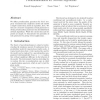117
Voted
STOC
1994
ACM
15 years 4 months ago
1994
ACM
We indicate strong non-approximability factors for central problems: N1/4 for Max Clique; N1/10 for Chromatic Number; and 66/65 for Max 3SAT. Underlying the Max Clique result is a...
89
Voted
STOC
1994
ACM
15 years 5 months ago
1994
ACM
100
Voted
STOC
1994
ACM
15 years 5 months ago
1994
ACM
Givenn points in the Euclideanplane,we considerthe problemof findingthe minimumtree spanninganyk points.The problemis NP-hardand we givean O(logk)-approximationalgorithm. Key Words...
102
click to vote
STOC
1994
ACM
15 years 5 months ago
1994
ACM
Razborov and Rudich have shown that so-called natural proofs are not useful for separating P from NP unless hard pseudorandomnumber generators do not exist. This famous result is ...
112
Voted
STOC
1994
ACM
15 years 5 months ago
1994
ACM
Shannon's Coding Theorem shows that in order to reliably transmit a message of T bits over a noisy communication channel, only a constant slowdown factor is necessary in the ...
152
Voted
STOC
1994
ACM
15 years 5 months ago
1994
ACM
Interactions among agents can be conveniently described by game trees. In order to analyze a game, it is important to derive optimal (or equilibrium) strategies for the di erent p...
STOC
1994
ACM
15 years 5 months ago
1994
ACM
92
Voted
STOC
1994
ACM
15 years 5 months ago
1994
ACM
We define pseudorandom generators for Yao's twoparty communication complexity model and exhibit a simple construction, based on expanders, for it. We then use a recursive com...
STOC
1994
ACM
15 years 5 months ago
1994
ACM
106
click to vote
STOC
1994
ACM
15 years 5 months ago
1994
ACM
Recent work has shown many advantages to randomly wired expander-based networks. Unfortunately, the wiring complexity of such networks becomes physically problematic as they becom...





